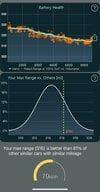This is why the mileage guess-o-meter is so misleading and frustrating to new users. If I set my percentage to 80, it (generally) charges to 80 and I see that I have 80% of my charge remaining. If I have it set to "miles," and then select 80%, the number of "miles" it stops at will vary wildly from day to day, week to week, based on how low I'm discharging it etc. It causes people to think their battery has degraded when that "miles" number decreases... or to think that the health of the battery has improved when the number increases. It's a very unhelpful metric and new users obsess over it and think there's something wrong when the number of "miles" on a charge changes. It's an estimate -- the BMS sometimes goes out of sync/calibration and adjusts what it thinks you have left in "miles." We all know those miles are accurate anyway.
It used to bother me when people would post "change it to percent and don't worry about the miles" as it seemed dismissive; however, after having Teslas for about 3 years, I think it's very sound advice. If you charge to a certain percentage (e.g. 80%), you rarely worry if it's the same 80% as it was last week. I feel like there'd be a lot less posts about this kind of stuff if we weren't presented with the inaccurate mileage estimates at all.



